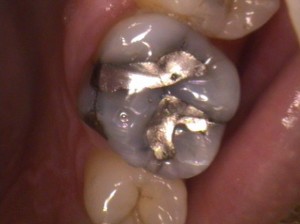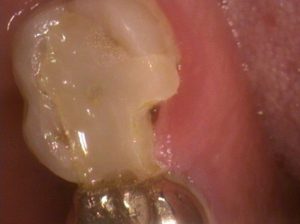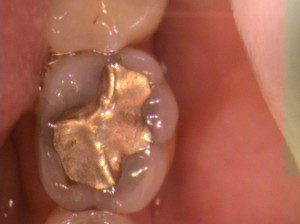How do I know my tooth is cracked?
 One of the most common reasons people come into the dental office is for a cracked tooth. Either a portion of the tooth has fractured off or the tooth is sensitive to biting on hard foods such as breads, especially sour dough, bagels granola or nuts. This sensitivity is a sharp electrical sensation or a feeling of weakness in the tooth, like “don’t bite on me here” when pressure is applied to a particular area when chewing food. It is not a deep sensation that occurs spontaneously or is associated with swelling.
One of the most common reasons people come into the dental office is for a cracked tooth. Either a portion of the tooth has fractured off or the tooth is sensitive to biting on hard foods such as breads, especially sour dough, bagels granola or nuts. This sensitivity is a sharp electrical sensation or a feeling of weakness in the tooth, like “don’t bite on me here” when pressure is applied to a particular area when chewing food. It is not a deep sensation that occurs spontaneously or is associated with swelling.
Amazingly teeth often fracture without any pain or forewarning. Some people comment the tooth actually “feels” better after the tooth structure has fallen off and is no longer breaking. Often their main complaint is that the sharp edge is cutting their tongue. I have personally broken two teeth on corn nuts and I never felt it coming. In fact I broke one tooth chewing corn nuts, didn’t learn my lesson, ate corn nuts the next day and broke the same tooth on the opposite side. Thank goodness I never experienced any sensation or pain before or after the teeth broke because I was in the middle of no where on a surf trip. My advice is to avoid corn nuts or at least pay attention if your body parts start coming off and change what you are doing.
 If a portion of the tooth comes off the diagnosis of which tooth is cracked is not difficult: We call it “Tooth in hand disease”. The question at that point becomes has the nerve been damaged and can the tooth be saved, i.e. is there enough tooth left to save. X-rays and a visual exam enable us to determine if we can save the tooth. Sometimes it requires “dental heroics”, but only five percent of fractured teeth cannot be saved. If only a small sliver of the tooth has fractured off and the tooth has no sensitivity to biting, a filling may be used to fill in the lost tooth structure. If the tooth has sensitivity to biting firm objects like a Q tip, the fracture is continuing past the part that fell off and the tooth may require a crown. If a significant portion of the tooth is lost a crown will be needed to hold the tooth together and replace the lost, tooth structure.
If a portion of the tooth comes off the diagnosis of which tooth is cracked is not difficult: We call it “Tooth in hand disease”. The question at that point becomes has the nerve been damaged and can the tooth be saved, i.e. is there enough tooth left to save. X-rays and a visual exam enable us to determine if we can save the tooth. Sometimes it requires “dental heroics”, but only five percent of fractured teeth cannot be saved. If only a small sliver of the tooth has fractured off and the tooth has no sensitivity to biting, a filling may be used to fill in the lost tooth structure. If the tooth has sensitivity to biting firm objects like a Q tip, the fracture is continuing past the part that fell off and the tooth may require a crown. If a significant portion of the tooth is lost a crown will be needed to hold the tooth together and replace the lost, tooth structure.
The more difficult situation to diagnose is the tooth that has a fracture, but has not cracked all the way and lost part of the tooth. This situation has confounded dentists for ages and has frustrated both patients and dentists alike. The problem is that radiographs do not show the crack, and if they do the tooth is often a lost cause. For a fracture to show up on an x-ray, it has to have split the tooth creating a wide gap and the x-ray beam has to line up perfectly with the crack, at an almost impossible angle. In thirty years of practice I have only seen a few fractures on an x-ray, and unfortunately none of the teeth were savable.
 The problem with a fractured tooth that has not lost any tooth structure is that the only way to find it is by the patient’s symptoms, and often they are very confusing. The sensitivity is often random and only occurs with specific textures of food chewed in just the right way. When you look in to try to see which tooth it is, all you see is partially chewed food. The tooth usually does not hurt when the teeth come together without something in between them or even when you tap on them. Additionally the patient often subconsciously “learns” not to chew in a particular manner. The fracture only moves when the part of the tooth is pushed in just the right direction which causes the fracture to spread, causing the nerve to feel pain. Hence the sporadic nature of the sensation. The rapid nature of the pain and the patient’s desire to avoid the pain makes it more difficult for the patient to determine which tooth it is. To make matters even more confusing, often a cracked tooth will get its wires crossed with other teeth, and “feels” like it is further forward or backward or sometimes even on the top and bottom at the same time. We do look for visible fracture lines but many teeth have craze lines in them that may not represent a true fracture in the tooth. If you look in a lighted mirror you will see multiple craze lines in most teeth. All of these things make finding the fracture difficult.
The problem with a fractured tooth that has not lost any tooth structure is that the only way to find it is by the patient’s symptoms, and often they are very confusing. The sensitivity is often random and only occurs with specific textures of food chewed in just the right way. When you look in to try to see which tooth it is, all you see is partially chewed food. The tooth usually does not hurt when the teeth come together without something in between them or even when you tap on them. Additionally the patient often subconsciously “learns” not to chew in a particular manner. The fracture only moves when the part of the tooth is pushed in just the right direction which causes the fracture to spread, causing the nerve to feel pain. Hence the sporadic nature of the sensation. The rapid nature of the pain and the patient’s desire to avoid the pain makes it more difficult for the patient to determine which tooth it is. To make matters even more confusing, often a cracked tooth will get its wires crossed with other teeth, and “feels” like it is further forward or backward or sometimes even on the top and bottom at the same time. We do look for visible fracture lines but many teeth have craze lines in them that may not represent a true fracture in the tooth. If you look in a lighted mirror you will see multiple craze lines in most teeth. All of these things make finding the fracture difficult.
So how do we know which tooth is cracked?
So, how do we determine which tooth is causing the symptoms and has a fracture…very carefully and cautiously. We test the teeth checking each point on the tooth to biting pressure, using a Q-tip and special dental instruments. We test multiple times and make sure the symptoms are reproducible. We look to correlate the sensitivity with visual fractures lines especially those that appear more significant with stains or that we can feel with an explorer. We take x-rays to rule out decay and to check the health of the nerve. Sometimes even with both doctor amd patient doing their best, we can not determine which tooth is giving the symptoms. At that point we may simply have to wait until the symptoms localize or have a specialist evaluate the tooth. What we do not do is guess, and treat a tooth that may or may not have a crack.
How do we treat cracked teeth?
Fortunately the permanent treatment for most cracked teeth is simply putting a crown on the tooth which serves to strengthen the tooth by holding it together, replacing the broken crystal structure of the tooth. The nerve is then able to heal itself and repair because it is no longer being irritated by the fracture moving through the tooth structure. Unfortunately, some fractured teeth require more than just a crown because the nerve is irreversibly damaged by the crack. In my experience of thirty years, approximately 20% of fractured teeth require a root canal at sometime during the tooth’s life. Why? Because the nerve can be damaged by the fracture, but survive for many years before it goes to the dark side. We can not predict which tooth is going to need root canal treatment even with x-rays because the x-rays lag behind what is going on by about six to eight weeks. If the tooth before or after the fracture is treated has spontaneous pain, pain that lasts more than six seconds with biting or produces pain that requires pain medication consistently, the tooth may likely need a root canal.
Other conditions that can create similar symptoms include tooth grinding, sinus infections, and acid reflux, so your most important job as a patient is to pay attention to what your teeth are telling you. If you need our help let us know.
